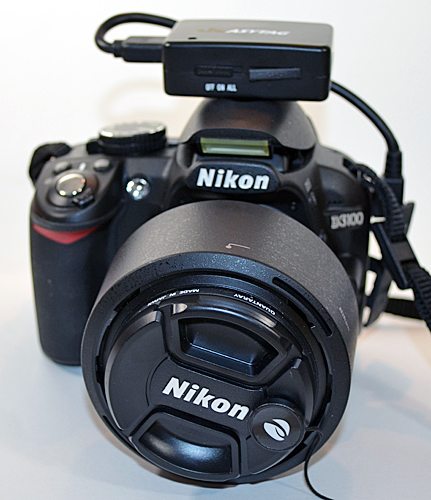 I have a couple of Nikon DSLR cameras that I use for personal and Gadgeteer photography. Nikon cameras aren’t cheap, but hey – not every camera is mentioned in song, either. 😉 Accessories, especially the Nikon-branded ones, aren’t cheap, either. I’ve been slowly collecting studio lights, flashes for the hot shoe, filters – you get the idea. One accessory I was intrigued by was Nikon’s GPS accessory to add geographical coordinates into the EXIF information of the photos I take. The GP-1 is expensive and there are things I need more, so I had forgotten about GPS info for my photos for the time being. That is until EasyTag offered their EasyTagger for Nikon cameras to The Gadgeteer for review. Let’s see how it worked for me.
I have a couple of Nikon DSLR cameras that I use for personal and Gadgeteer photography. Nikon cameras aren’t cheap, but hey – not every camera is mentioned in song, either. 😉 Accessories, especially the Nikon-branded ones, aren’t cheap, either. I’ve been slowly collecting studio lights, flashes for the hot shoe, filters – you get the idea. One accessory I was intrigued by was Nikon’s GPS accessory to add geographical coordinates into the EXIF information of the photos I take. The GP-1 is expensive and there are things I need more, so I had forgotten about GPS info for my photos for the time being. That is until EasyTag offered their EasyTagger for Nikon cameras to The Gadgeteer for review. Let’s see how it worked for me.
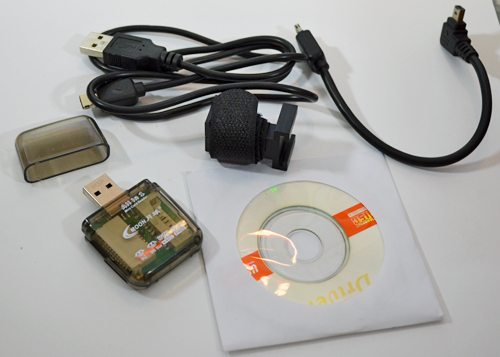 The EasyTagger comes with a USB-to-proprietary-plug cable for charging, a Nikon-to-proprietary-plug cable for connection to the camera, a column for attaching to the hot shoe while still allowing the built-in flash to be used, a cable strap, a card reader, and a small CD with the manual. When you order the EasyTagger, you select the appropriate cable for the camera you own. Luckily, the N3 cable will work with both my Nikon D3100 and D5100. Instead of using the undersized CD that never properly works with my MacBook Pro, I downloaded the manual from the EasyTag website. The CD was labeled “Setup Software”, but I didn’t need any software to use the EasyTagger.
The EasyTagger comes with a USB-to-proprietary-plug cable for charging, a Nikon-to-proprietary-plug cable for connection to the camera, a column for attaching to the hot shoe while still allowing the built-in flash to be used, a cable strap, a card reader, and a small CD with the manual. When you order the EasyTagger, you select the appropriate cable for the camera you own. Luckily, the N3 cable will work with both my Nikon D3100 and D5100. Instead of using the undersized CD that never properly works with my MacBook Pro, I downloaded the manual from the EasyTag website. The CD was labeled “Setup Software”, but I didn’t need any software to use the EasyTagger.
Specifications
- GPS Chipset SiRF Star III
- Frequency L1, 15 75.4 2 MHz
- C/A Code 1.0 23 MHz chip rate
- Channels 20 channel all-in-view tracking
The manual has a lot more technical information in it, but it has quite a few typos that I’m not sure how to correct. If you really want to see more details, you can download the manual here.
The EasyTagger GPS unit is made of black plastic. It measure 2″ X 1.25″ X about 0.85″ thick (including the hot shoe connector). It weighs 1.4 ounces on my digital kitchen scale.
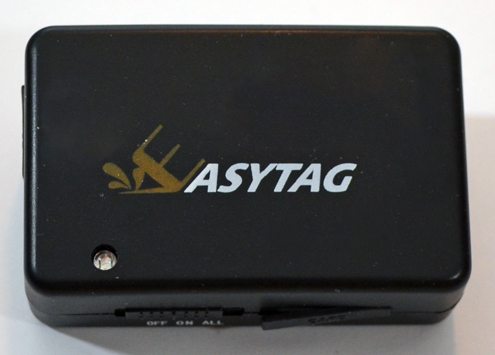 The top of the EasyTagger has an LED status light that tells you when calibration is complete, when a signal has been established, etc.
The top of the EasyTagger has an LED status light that tells you when calibration is complete, when a signal has been established, etc.
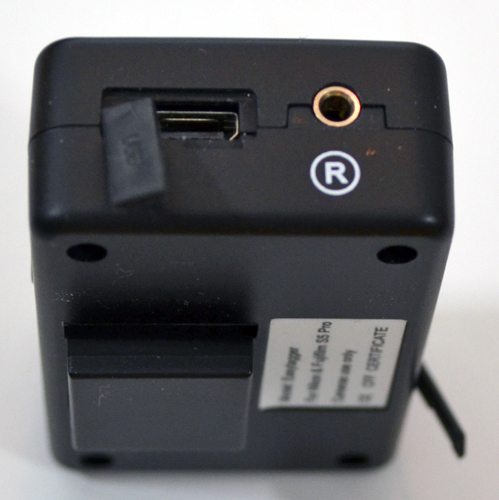 This end has a port, covered by a rubber door that broke off when I tried to connect the unit to my camera, with a non-standard connector type. This is where you connect the charging cable and also where you connect the camera cable.
This end has a port, covered by a rubber door that broke off when I tried to connect the unit to my camera, with a non-standard connector type. This is where you connect the charging cable and also where you connect the camera cable.
The EasyTagger has a 500mAh Li-ion battery that recharges with any standard USB charger or a port on your computer. This battery powers the GPS unit so that it doesn’t suck your camera battery dry.
The circular port is to connect a remote control unit that can fire the shutter of the Nikon camera. I didn’t receive one with the review unit, and I don’t own a wired remote for either of my cameras.
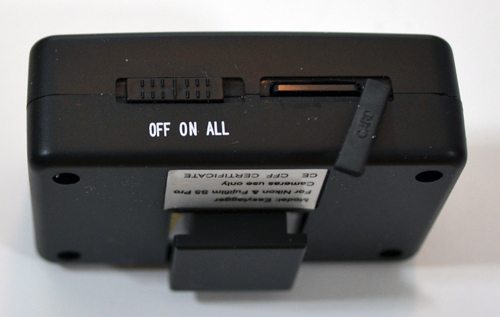
 The EasyTagger comes with a 2GB microSD card, already installed. It stores GPS data in standard GPS log files on the disk. EasyTag includes a USB card reader so you can access this data on your computer.
The EasyTagger comes with a 2GB microSD card, already installed. It stores GPS data in standard GPS log files on the disk. EasyTag includes a USB card reader so you can access this data on your computer.
Best of all, the EasyTagger also writes GPS coordinates, altitude, and barometric readings directly into the photo file’s metadata if you’re using RAW, JPG, and TIFF formats (for most cameras). You don’t have to use the log files if your software can use the metadata information.
The power slider is here, too. In the ON position, the EasyTagger “will track all visible satellites and receive GPS data. It will provide instant location information to the camera whether the camera is turned On or Off.” In the OFF position, the unit is powered off, but the remote control will still work to control the camera if it’s plugged into the GPS unit. The ALL position means the “Easytagger and the data logger are “On”. GPS signals will be logged every 10 seconds to the Micro SD card.”
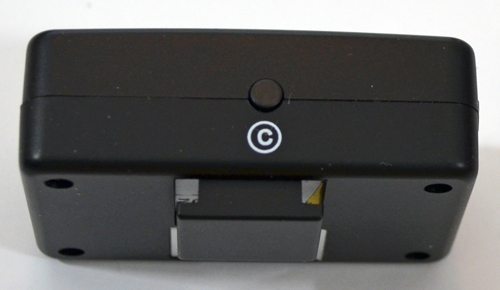 This is the calibrate button. Calibration was easy. You simply slide the EasyTagger on to the hot shoe and connect the cable, press the calibrate button, then turn yourself through 360-degrees twice while holding the camera level and pointed at the horizon. This should be done outdoors with an unobstructed sky view, so it may make your neighbors wonder what you’re doing. My EasyTagger calibrated quickly, so I didn’t have time to attract an audience.
This is the calibrate button. Calibration was easy. You simply slide the EasyTagger on to the hot shoe and connect the cable, press the calibrate button, then turn yourself through 360-degrees twice while holding the camera level and pointed at the horizon. This should be done outdoors with an unobstructed sky view, so it may make your neighbors wonder what you’re doing. My EasyTagger calibrated quickly, so I didn’t have time to attract an audience.
It took a few seconds before my Nikon D3100 recognized the presence of the EasyTagger GPS. A GPS icon blinked on my camera’s status screen for a few moments before coming on steady. At this point, I tried a test picture, and there was GPS information in the file’s data.
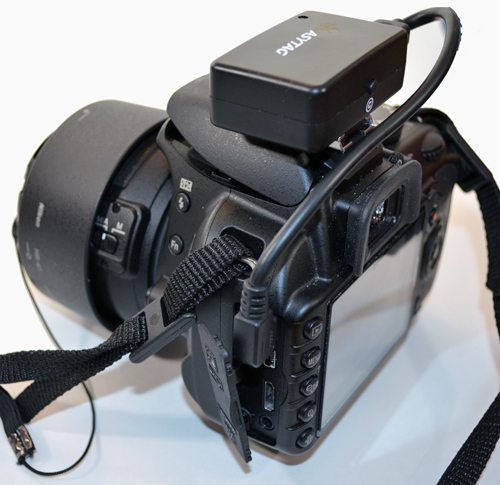 On the EasyTag website, the power connector on the GPS unit is shown to be on the same side as the camera’s GPS connection. That wasn’t the case for my D3100 nor the D5100, but luckily enough, the cable was just long enough to reach the connector. You can see here that the GPS unit hangs over the built-in flash unit, and it prevents the flash from opening. You can see the flash unit is open, but it can’t lift into position in this picture and the topmost picture. You can use the included hot shoe extender column to elevate the GPS unit so the flash can pop up. I was going to be taking pictures outdoors, so I didn’t need the extender for this trial.
On the EasyTag website, the power connector on the GPS unit is shown to be on the same side as the camera’s GPS connection. That wasn’t the case for my D3100 nor the D5100, but luckily enough, the cable was just long enough to reach the connector. You can see here that the GPS unit hangs over the built-in flash unit, and it prevents the flash from opening. You can see the flash unit is open, but it can’t lift into position in this picture and the topmost picture. You can use the included hot shoe extender column to elevate the GPS unit so the flash can pop up. I was going to be taking pictures outdoors, so I didn’t need the extender for this trial.
We decided to combine my daughter’s driving practice with some photography, so we drove around town snapping pictures. Some pictures were taken while the car was stationary, others while the car was moving. Acquisition rates vary: hot start 1 sec., average; warm start 38 sec., average; cold start 42 sec., average; reacquisition 0.1 sec., average.
Some of our pictures were missing GPS information, so I imagine most of those were taken while the car was moving and the GPS unit didn’t have time to get a new signal, or perhaps there was something overhead interfering with the signal acquisition. Most of the pictures did have the information.
All of the following pictures can be clicked for an enlarged view.
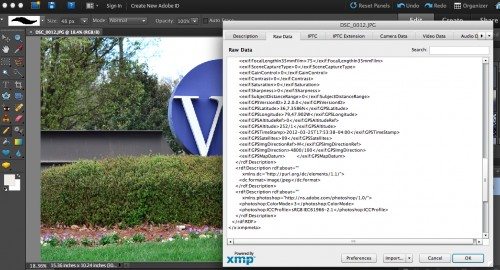 This screen capture shows the part of the metadata where the GPS information is found. I used Photoshop Elements 9 to open the file and show the information. If you click on the above photo, you’ll also be able to see that the number of satellites the signal was collected from is also displayed. Most pictures showed 6 satellites, but I saw as many as nine.
This screen capture shows the part of the metadata where the GPS information is found. I used Photoshop Elements 9 to open the file and show the information. If you click on the above photo, you’ll also be able to see that the number of satellites the signal was collected from is also displayed. Most pictures showed 6 satellites, but I saw as many as nine.
The GPS data in the photo is available to all geotagging software. I don’t currently own any software designed to use this data, so I just uploaded some of my pictures to Flickr and added them to the map.
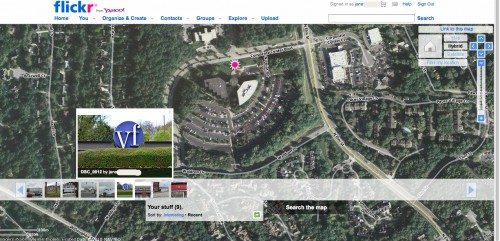 The photo of this sign was taken while the car was stationary. You can’t possibly tell by looking at this map if the pin is in the correct position unless you’re familiar with this part of Greensboro. I’m familiar with the area, and I can tell you that the pin is directly in front of the VF Corporation World Headquarters building, right about where the pictured sign is located.
The photo of this sign was taken while the car was stationary. You can’t possibly tell by looking at this map if the pin is in the correct position unless you’re familiar with this part of Greensboro. I’m familiar with the area, and I can tell you that the pin is directly in front of the VF Corporation World Headquarters building, right about where the pictured sign is located.
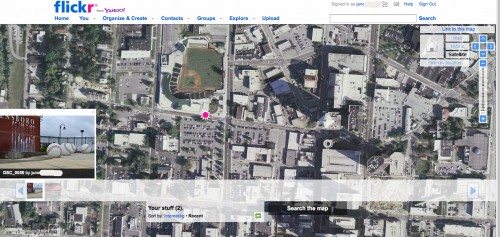 You can tell by the photograph that this was taken at the Greensboro baseball stadium. This photo was taken while the car was moving. I’m not sure if the pin is exactly where those baseball “sculptures” are located. Perhaps the car was moving a bit faster than the GPS data updated, but it’s close enough that you could certainly use the information to get back to the stadium.
You can tell by the photograph that this was taken at the Greensboro baseball stadium. This photo was taken while the car was moving. I’m not sure if the pin is exactly where those baseball “sculptures” are located. Perhaps the car was moving a bit faster than the GPS data updated, but it’s close enough that you could certainly use the information to get back to the stadium.
 This map shows pins and small thumbnails for each of the photos I uploaded.
This map shows pins and small thumbnails for each of the photos I uploaded.
The GPS data collected by the EasyTagger is accurate, as you can tell from the maps. I don’t know about the altimeter and the barometric pressure readings collected by the GPS unit, because I have no way to check their accuracy.
I think the EasyTagger is a great accessory for my Nikon cameras. It costs less than half the price of the GP-1 ($120 for the EasyTagger vs. $265 for the Nikon GP-1). Luckily, the cable I got works for both my cameras, but I can buy a new cable from EasyTag for $10 if I get a new Nikon in the future. I could add a shutter release for $4-29, depending on the features I want for the release cable. You might even be interested to know that a user named retiredPhil left a bad review for the Nikon GP-1 at the Nikon website and said he “would have been much better off buying a 3rd party geo locator, such as the Easytagger GPS.” I think you’d agree with retiredPhil and me that the EasyTagger is a great, inexpensive GPS unit for your Nikon camera.
Google Review Tap Cards (3-Pack) by TapFive - Tap for Instant Reviews - All Phones Compatible - Reusable Smart Tap NFC & QR - Boost Business Reviews - Powered by TapFive (3 Card Pack)
$34.90 (as of August 31, 2025 18:20 GMT -04:00 - More infoProduct prices and availability are accurate as of the date/time indicated and are subject to change. Any price and availability information displayed on [relevant Amazon Site(s), as applicable] at the time of purchase will apply to the purchase of this product.)Google Review Tap Card Stand | Boost Online Reviews and Google Rank with Fast Zappy NFC Tap QR Code Stand Works Like Digital Business Card | Compatible with iPhone and Android Devices (1 Large Stand)
$14.99 (as of August 31, 2025 18:20 GMT -04:00 - More infoProduct prices and availability are accurate as of the date/time indicated and are subject to change. Any price and availability information displayed on [relevant Amazon Site(s), as applicable] at the time of purchase will apply to the purchase of this product.)Product Information
| Price: | $120.00 |
| Manufacturer: | EasyTag |
| Retailer: | EasyTag |
| Pros: |
|
| Cons: |
|



Gadgeteer Comment Policy - Please read before commenting
Seems the Easytagger installed in a wrong direction.
@casey It was installed in the only direction it would fit on the camera’s hot shoe.
Hi!
I would like to install the geotagger in my battery grip. The dimensions of the geotagger box itself are too large to fit. Thus, I am desperately searching for the dimensions of the platines (Unscrewed, without black box)? Could anyone provide me with those? If possible, does anyone have pictures of the geotagger unscrewed?
Thank you very much
Max
This unit is very poorly made. Testing on Day 1 and Day 2 is nice, but try using it all the way to Day 40 and Day 100 and you will see that cable connecting GPS unit to camera fails since its GPS side end is made out of weak plastic and not heavy duty at all. Also the unit is plagues with bugs: one in 5-10 images doesn’t get tagged with Nikon D300, unit synchronizes with GPS signal way too long, sometimes 10 minutes, sometimes it writes wrong (same) GPS coordinates into several sequential images. Sometimes it loses synchronization under the clear sky for no apparent reason. Sometimes light on the GPS unit is steady (meaning that GPS signal is fine) and GPS indicator on the camera flashes (indicating there is no steady signal). Also magnetic compass never works.
Don’t buy this unit if you plan to use it for a long time, you will regret it. Go with some more robust and stable solution, like connecting hikers GPS to the camera.
Hi Casey, you have mounted in a wrong direction. That caused the connection problem of the GPS. And the satellite signal are indeed weak sometimes in a day. The GPS module may not work fine sometime. But we always try our best to do the aftersale service to meet customers satisfaction. And do you mind follow up a reply there? I represent the EasyTagger support team.
Just got my EasyTagger couple days ago.
Day 1 at beach could not in multiple tries get satellite lock (Apx 10-15min try times)
Day 2 took unit for walk along beach and left on, got first lock in apx 20-30 min (Didn’t check constantly)
My iPhone 5 (No WiFi) app MotionX locked in seconds and showed strong Satellite signal.
I found the unit was very quick to lose lock. Relocks after turning unit off then took 3 to 5 minutes.
I’d say the unit has very poor sensitivity and accuracy.
I feed the data into Google’s GPS Visualize and fount it showed me walking randomly on water out in bay. LOL but not funny.
I’n give this unit a Fail
I just purchased the newer version with the MTKII chipset and this thing rocks. It takes somewhere between 45 to 60 seconds to lock into the satellites(as long as you don’t move i.e. driving in a car). If you will like to compare the MTKII chipset with other chipsets please go to http://www.canadagps.com/KB_04.html The Auto geotag indoor feature works flawlessly, especially when you do your own geotagging with other software.
I purchased the Bluetooth version for my Nikon D7000, It works great but I use the self geotagging feature(recording coordinates every 10 sec) since my wife has a Sony NEX 5 and I geotag pictures from both cameras. Calibration is easy just follow the instructions.
I’m a MAC user and I use myTracks app that I downloaded from the Apple store for $15. Easytagger creates a txt. file, you will then go to GPS Visualizer website http://www.gpsvisualizer.com and convert the file to a GPX file. You will then load that GPX file into myTracks with the pictures and voila. The great thing about the eassytagger is that it writes the file with the location and time so you don’t have to worry with the offset time on the pictures when you geotag them. This way I can geotag my wife’s and my pictures. It really does not take that long FYI I take RAW pictures and I’m station in Guam and this thing works in this little island in the middle of the Pacific.
The flexibility of the geotagger was the reason I bough it. The Nikon GPS unit needs to be connected to the camera(limiting the use of the flash/hot shoe) at all times for it to work, with the eassytagger in the manual mode you don’t have to, the eassytagger it’s so small that I just leave it in my camera bag. There are other geotagging devices, but with old chipsets and for the same price.
Costumer service is top notch. Before I purchased the product I had a lot of questions and Bryan, easytagger costumer service representative was very quick with his responses, and very technical btw.
Where can I get a new usb charging cable?